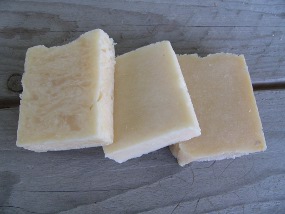I have always loved beautiful white bars of soap. Unfortunately, with natural colorants pure white is not that easy to produce. So I decided that it was time to try titanium dioxide for the first time. I have been a bit puzzled about the titanium dioxide. Some say that it is a natural colorant but I doubt that those that are sold in stores are in fact synthetic. That's why I probably will not use it anymore, but it was interesting to try!
These are all oven hot process soaps made with the jojoba wax recipe. In the picture the first bar on the left is from a batch in which I mixed the titanium dioxide diluted in small amount of water after the cook.
Then I wanted to have a more even color and made another batch where I added it in the oils before mixing in the lye solution. I was a bit worried if it would speed up the trace, but that didn't happen.
I wanted to compare the result with some natural colorant. I had read from several sources that also Kaolin clay gives white color. The one on the right has Kaolin clay added before the cook. The color is not even close to white! It is tan or maybe even beige and after it cured it actually became even darker. I wonder if there are different qualities of Kaolin that would produce different tones. Also, the weirdest thing happened, the batch with Kaolin came out really soft. I have no idea why!
These are all oven hot process soaps made with the jojoba wax recipe. In the picture the first bar on the left is from a batch in which I mixed the titanium dioxide diluted in small amount of water after the cook.
Then I wanted to have a more even color and made another batch where I added it in the oils before mixing in the lye solution. I was a bit worried if it would speed up the trace, but that didn't happen.
I wanted to compare the result with some natural colorant. I had read from several sources that also Kaolin clay gives white color. The one on the right has Kaolin clay added before the cook. The color is not even close to white! It is tan or maybe even beige and after it cured it actually became even darker. I wonder if there are different qualities of Kaolin that would produce different tones. Also, the weirdest thing happened, the batch with Kaolin came out really soft. I have no idea why!

Heidi, Titanium Dioxide is a naturally occuring oxide of titanium and is found as a mineral in weathering rims. The name sounds like a nasty chemical, but no worries - it is not. Best mixed in a little bit of oil, then into one part of your soap pudding, then incorporate into the whole. White or light Kaolin will give you a yellowing in soap. I like to use it in my shaving bars, but just for its properties of giving a nice 'slip'. My whitest bars without TD were with oils of Coconut/Palmkernel/Sunflower /Canola
ReplyDeleteActually, TiO2 is a natural mineral, but after the purification process there is little natural left in it. A part of the titanium in ilmenite is not in the oxide form, and also part of the actual oxide in the chlorine purification process (the most commonly used) is converted to titanium tetrachloride, which is the reoxidised to TiO2. This does not happen in the sulfate process, but the Tio2 of the sulfate process is of inferior quality, and the process itself highly polluting. The waste products in the purification of TiO2 are many and the environmental impact is fairly big, so I would avoid using TiO2 in anything you want to call ecological or natural.
ReplyDeleteouch!
ReplyDeleteHi Heidi, lovely soaps! In addition to Cocobong's list of oils, you could also try camellia oil. It has never disappointed me. :)
ReplyDeleteAnd Suvi, than you for such an informative explanation!
Cocobong and Between Friends: Thank you for the oil suggestions! I have never tried Camellia, Sunflower or Palmkernel oil. Camellia sounds very interesting since as far as I know it has long shelf life as well.
ReplyDeleteSuvi: Thank you for the explanation! It made me wonder how the purification processes of kaolin and coloured clays are. I hope I don't have to abandon them as well!